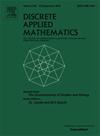色数为3或4的素数距离图的注释
IF 1
3区 数学
Q3 MATHEMATICS, APPLIED
引用次数: 0
摘要
素数距离图(PDGs)根据色数是1、2、3还是4分为四类。完整地描述色数为3或4的PDGs族仍然是一个悬而未决的问题。在这篇简短的说明中,我们给出了风扇和车轮成为PDGs的充分必要条件。我们还证明(1)一个PDG的n个边不相交的副本可以链接在一起形成一个PDG,(2)一个PDG与一条路径的笛卡尔积是一个PDG。本文章由计算机程序翻译,如有差异,请以英文原文为准。
A note on prime distance graphs with chromatic number 3 or 4
Prime distance graphs (PDGs) are divided into four classes depending on whether their chromatic number is 1, 2, 3 or 4. It is still an open problem to completely characterize the family of PDGs with chromatic number 3 or 4. In this brief note we give necessary and sufficient conditions for fans and wheels to be PDGs. We also show (1) edge-disjoint copies of a PDG may be chained together to form a PDG, and (2) the Cartesian product of a PDG with a path is a PDG.
求助全文
通过发布文献求助,成功后即可免费获取论文全文。
去求助
来源期刊

Discrete Applied Mathematics
数学-应用数学
CiteScore
2.30
自引率
9.10%
发文量
422
审稿时长
4.5 months
期刊介绍:
The aim of Discrete Applied Mathematics is to bring together research papers in different areas of algorithmic and applicable discrete mathematics as well as applications of combinatorial mathematics to informatics and various areas of science and technology. Contributions presented to the journal can be research papers, short notes, surveys, and possibly research problems. The "Communications" section will be devoted to the fastest possible publication of recent research results that are checked and recommended for publication by a member of the Editorial Board. The journal will also publish a limited number of book announcements as well as proceedings of conferences. These proceedings will be fully refereed and adhere to the normal standards of the journal.
Potential authors are advised to view the journal and the open calls-for-papers of special issues before submitting their manuscripts. Only high-quality, original work that is within the scope of the journal or the targeted special issue will be considered.
 求助内容:
求助内容: 应助结果提醒方式:
应助结果提醒方式:


